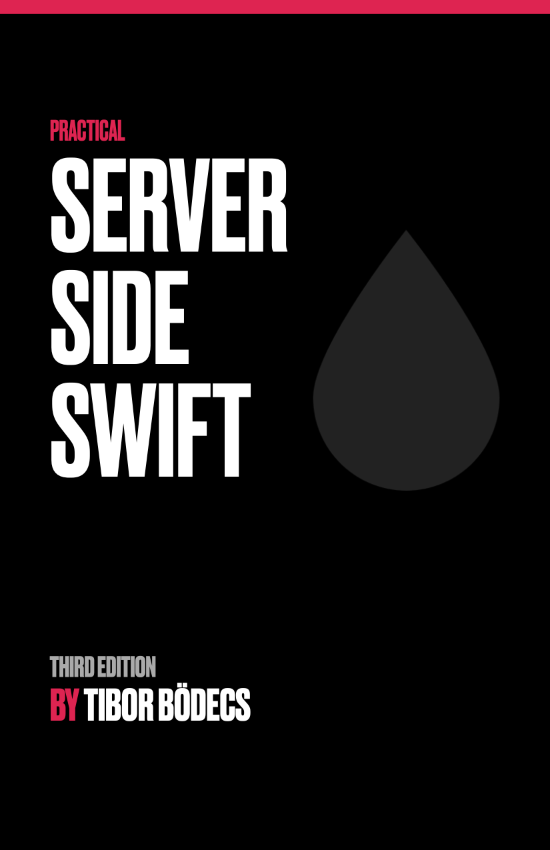How to use middlewares in Vapor 4?
Learn how to create middlewares for a Vapor based server side Swift application to handle common routing functionalities.
What is a middleware?
A middleware is basically a function that will be executed every time before the request handler. This way you can hook up special functionalities, such as altering the request before your handler gets the chance to respond to it. Let me show you a real-world example real quick.
import Vapor
final class ExtendPathMiddleware: Middleware {
public func respond(to request: Request, chainingTo next: Responder) -> EventLoopFuture<Response> {
if !request.url.path.hasSuffix("/") {
let response = request.redirect(to: request.url.path + "/", type: .permanent)
return request.eventLoop.makeSucceededFuture(response)
}
return next.respond(to: request)
}
}
I’m using this middleware to always extend my paths with a trailing slash character. Just try to delete the last char from the URL here on my site & press enter, you’ll be redirected to the original path with a “/” suffix, since the middleware is doing its job. 👨💻
A middleware function has two input parameters. The first one is the Request object that you can check or even alter its properties. The second one is the next reference in the Responder chain, so you can respond as usual (with your route handlers) if the middleware has nothing to do with the incoming request. You should always call the next.respond(to: request) method.
Using a middleware
In order to use the middleware from above you have to register it first. It is possible to use a middleware globally, you can hook up your middleware using the app.middleware.use(_) method. This way the registered middleware will be applided for every single route in your Vapor server.
import Vapor
public func configure(_ app: Application) throws {
// ...
app.middleware.use(ExtendPathMiddleware())
}
The other option is to apply a middleware to specific subset of routes.
let middlewareRoutes = app.grouped(ExtendPathMiddleware())
middlewareRoutes.get("hello") { req in
return "hello"
}
You can read more about routing in the official Vapor 4 docs. I also prefer to have a dedicated router class for my modules (I’m using kind of a VIPER architecture on the server side). 😜
final class MyRouter: RouteCollection {
func boot(routes: RoutesBuilder) throws {
routes.grouped(ExtendPathMiddleware()).get("hello", use: self.hello)
}
func hello(req: Request) -> String {
return "hello"
}
}
// config
try app.routes.register(collection: routes)
That’s how I utilize middlewares in my Vapor apps. Honestly I don’t have that much custom middlewares, but the ones I implemented helps me a lot to solve common problems.
Built-in middlewares
There are some useful middlewares built right into Vapor.
File middleware
The FileMiddleware allows you to serve static assets from a given folder. This comes handy if you are using Vapor without an nginx server, so you can serve images, stylesheets, javascript files with the client (browser). You can setup the middleware like this:
import Vapor
public func configure(_ app: Application) throws {
// ...
app.middleware.use(FileMiddleware(publicDirectory: app.directory.publicDirectory))
}
You can configure the path of your resources by passing the publicDirectory input parameter.
CORS middleware
In short, CORS allows you to share resources between multiple domains.
Cross-origin resource sharing (CORS) is a mechanism that allows restricted resources on a web page to be requested from another domain outside the domain from which the first resource was served.
This comes handy if you are developing frontend apps by using Leaf & Vapor. This middleware will replace or add the necessary CORS headerss to the response. You can use the default config or initialize a custom one, here is the Swift code for using the CORS middleware:
import Vapor
public func configure(_ app: Application) throws {
// ...
// using default configuration
app.middleware.use(CORSMiddleware(configuration: .default()))
// using custom configuration
app.middleware.use(CORSMiddleware(configuration: .init(
allowedOrigin: .originBased,
allowedMethods: [.GET, .POST, .PUT, .OPTIONS, .DELETE, .PATCH],
allowedHeaders: [.accept, .authorization, .contentType, .origin, .xRequestedWith]
)))
}
If you want to learn more about how these middlewares work you should option+click on the name of the middleware in Xcode. This way you can browse the source files directly. 🔍
Error middleware
Route handlers can throw erros. You can catch those by using the ErrorMiddlware and turn them into proper HTTP responses if necessary. Here is how to setup the middleware:
import Vapor
public func configure(_ app: Application) throws {
// ...
// using the default error handler
app.middleware.use(ErrorMiddleware.default(environment: app.environment))
// using a custom error handler
app.middleware.use(ErrorMiddleware { req, error -> Response in
// implement custom response...
.init(status: .internalServerError, version: req.version, headers: .init(), body: .empty)
})
}
If you are developing an API service, this middleware is kind of an essential component. 💥
Auth related middlewares
The Authenticator protocol conforms to the Middleware protocol, so we can register anything that implements any of the Authenticator protocols. You can read more about how the auth layer works in Vapor 4 from my authentication tutorial.
The Authenticatable protocol has two static methods, they returns middlewares too. The first one is the guard middleware, which will throw an error if the user is not logged in. The second one is the redirect middleware, that redirects unauthenticated requests to the supplied path.
// The UserModelAuthenticator is an Authenticator
app.routes.grouped(UserModelAuthenticator())
// The UserModel object is Authenticatable
app.routes.grouped([
UserModel.guardMiddleware(),
UserModel.redirectMiddleware(path: "/"),
])
Multiple middlewares can be registered at once using an array.
Middlewares vs route handlers
Sometimes it’s useful to write a middleware, but in other cases a simple route handler can be more than enough. I’m not against middlewares at all, but you should consider which approach is the best for your needs. I usually go with simple handlers and blocks in 95% of the cases.
Middlwares are good for solving global problems, for example if you want to add a new header to every request it’s safe to use a middleware. Checking user permission levels? Not necessary, but yeah if you want to simplify things a middleware could work here as well. 🤔
Fun fact
This URL: https://www.google.com/////search?????client=safari&&&&&q=swift+vapor still works, despite the fact that it contains 5 slashes, question marks and ampersands. I don’t know why, but most of the websites are not checking for duplicates. Try with other domains as well.
If you want to learn how to build a custom middleware I think it’s a good practice to solve this issue. Write one that removes the unnecessary characters and redirects to the “right” URL.
Related posts
10 short advices that will make you a better Vapor developer right away
As a beginner server side Swift developer you'll face many obstackles. I'll show you how to avoid the most common ones.
A generic CRUD solution for Vapor 4
Learn how to build a controller component that can serve models as JSON objects through a RESTful API written in Swift.
A simple HTTP/2 server using Vapor 4
Get started with server-side Swift using the Vapor 4 framework. Learn how to build a really simple HTTP/2 backend server.
AJAX calls using Vapor 4
Learn how to implement Asynchronous JavaScript and XML (AJAX) calls using Leaf templates and Vapor 4 as a server.


